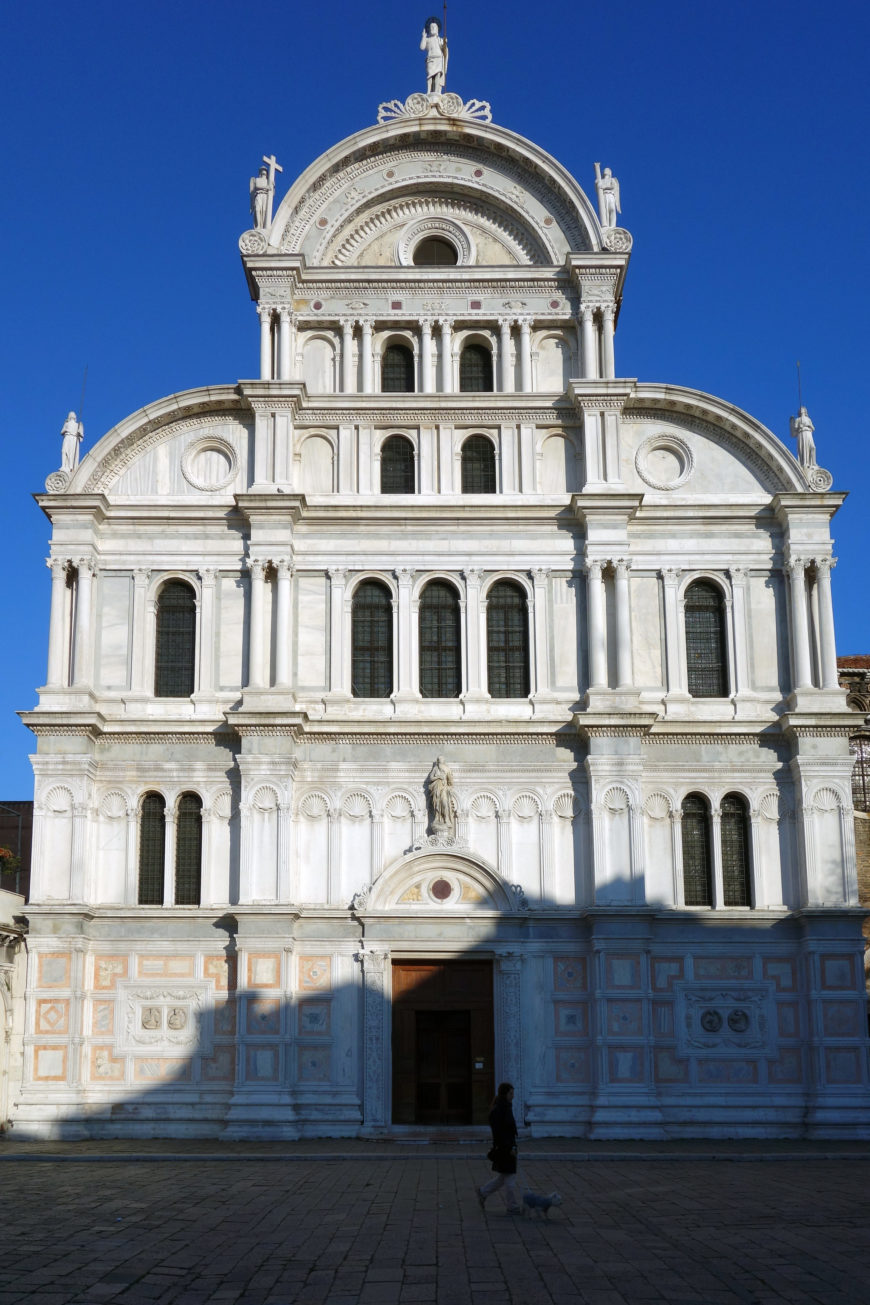Giovanni Bellini, San Zaccaria Altarpiece, 1505, oil on wood transferred to canvas, 16′ 5-1/2″ x 7′ 9″ inches (San Zaccaria, Venice)
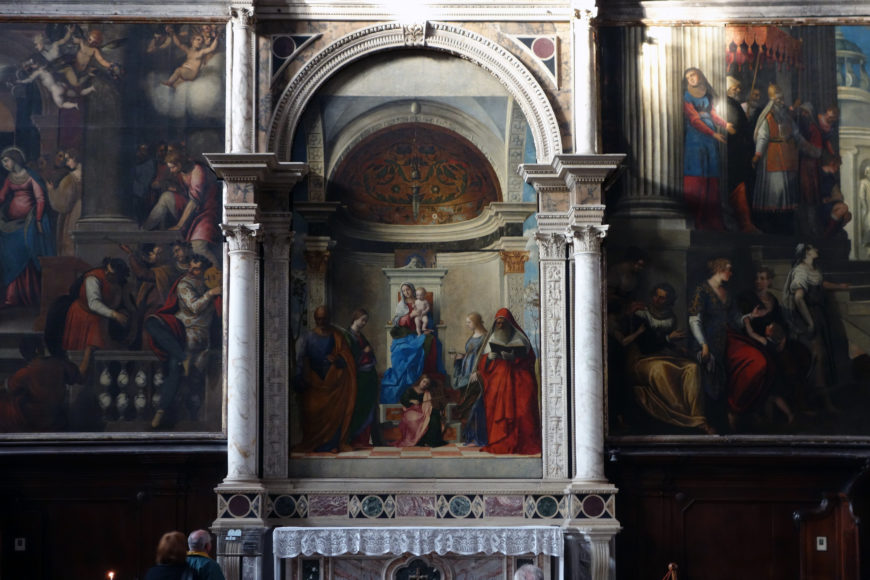
Giovanni Bellini, San Zaccaria Altarpiece, 1505, oil on wood transferred to canvas, 16 feet 5-1/2 inches x 7 feet 9 inches (San Zaccaria, Venice)
San Zaccaria, in Venice
We are fortunate that Bellini’s famous altarpiece can be seen in the church it was made for, San Zaccaria, in Venice.
San Zaccaria (Saint Zachary) is not a common name for a church — it is among a handful of Venetian churches named after Old Testament saints (more typically saints come from the New Testament and early Christian history). So how did Old Testament figures become saints?
According to Byzantine tradition, Christ spent three days in the underworld, breaking open the gates of hell to release the souls of the pre-Christian righteous who would otherwise not be able to share in the eternal life made possible by his crucifixion. Adam and Eve were the first to emerge, followed by other Old Testament people like Moses, Job and Zachary, all three of whom have churches named after them in Venice. This “harrowing of hell,” as it is known, was largely rejected in evolving Christian doctrine because of a lack of Biblical evidence, which explains why we don’t often encounter St. Moses or St. Zachary in paintings. Perhaps that disagreement about the doctrinal soundness of the harrowing of hell (also called Anastasis in the Byzantine tradition) explains why there is no depiction of St Zachary in the altarpiece by Bellini named for his church.
The fact that such an altarpiece was commissioned from Bellini, who was the official civic painter of Venice, is a testament to the importance of the group of nuns who occupied the church monastery, many of them the daughters of prominent patrician families.
A sacred conversation — a new kind of altarpiece
The subject of the altarpiece is a sacred conversation (sacra conversazione), a type of painting that developed first in Florence and then in Venice. The sacred conversation describes a subject of the enthroned Virgin, holding the infant Christ, surrounded by standing saints of differing eras, accompanied by angels. All of the figures are united in a single space.
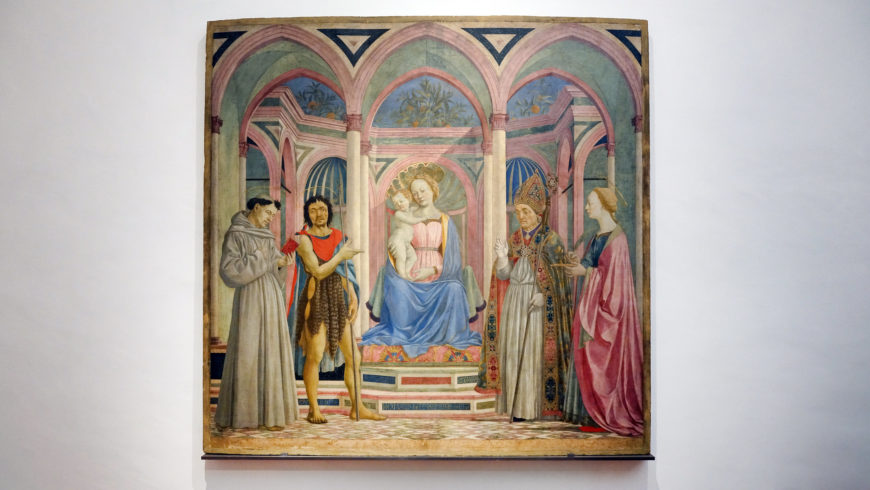
Perhaps the earliest true sacra conversazione — Domenico Veneziano, Saint Lucy Altarpiece (Madonna and Child enthroned with St. Francis, John the Baptist, St. Zenobius and St. Lucy), c. 1445, tempera on wood, 209 x 213 cm (Galleria degli Uffizi, Florence). Other early paintings that reduce the framing elements include Piero della Francesca’s Brera Altarpiece (1472-74) and Fra Filippo Lippi’s Barbadori Altarpiece (1438).
Earlier altarpieces tended to be polyptychs or triptychs (altarpieces made up of several different panels), each of them containing one or more saints, arranged around a separate central panel often depicting the enthroned Virgin and Child. The sacra conversazione removes those barriers to create a single assembly of figures who share a literal (as well as a psychological) space.
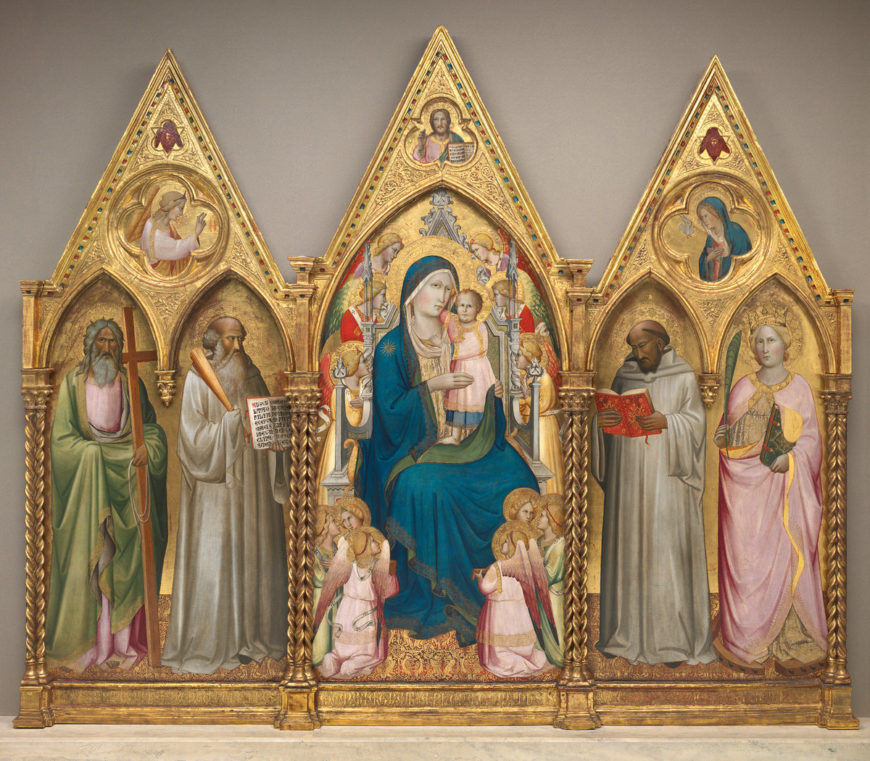
An example of an earlier triptych (three-panels): Agnolo Gaddi, Madonna and Child with Saints Andrew, Benedict, Bernard, and Catherine of Alexandria with Angels, shortly before 1387, tempera on poplar panel (National Gallery of Art, Washington D.C.).
In the San Zaccaria Altarpiece by Bellini, the individuals depicted are all aware of one another, and the viewer outside the painting shares this common space as well as this idea of inclusion and belonging. The Virgin, the saints, and the viewer are all from different times, but the artist has created a common space in which they can all assemble. The physical unity helps to promote a kind of silent communication, which is the essence of the sacred (and silent) conversation. The angels signify that, although this space looks real, it is of a different, transcendent order. They sometimes play instruments and appear to be singing; the music is a symbol of harmony.
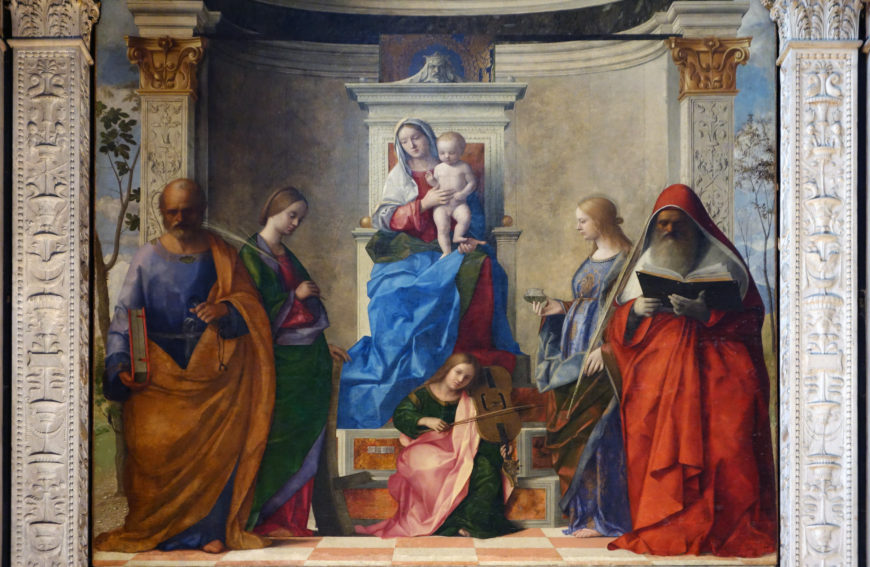
Giovanni Bellini, San Zaccaria Altarpiece (detail), 1505, oil on wood transferred to canvas, 16 feet 5-1/2 inches x 7 feet 9 inches (San Zaccaria, Venice)
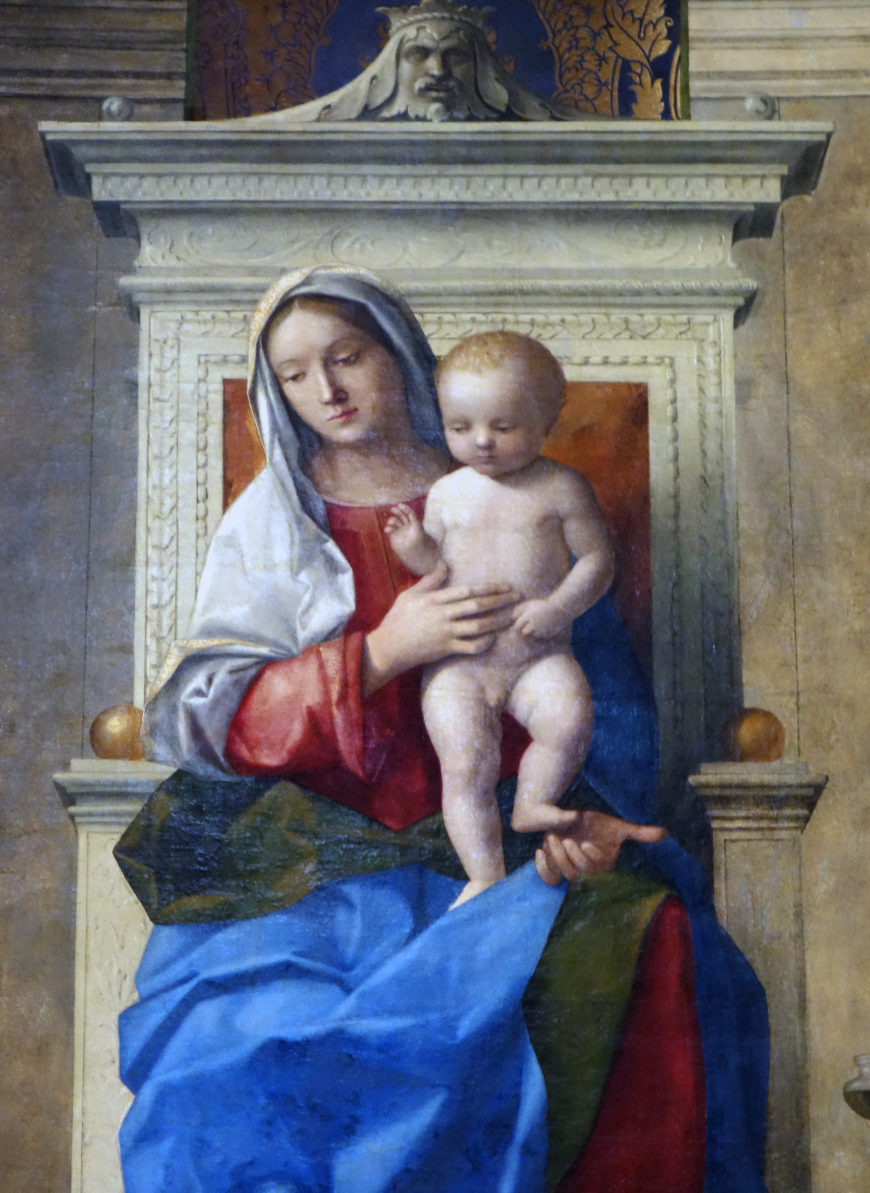
Mary and the Christ Child (detail), Giovanni Bellini, San Zaccaria Altarpiece (detail), 1505, oil on wood transferred to canvas, 16 feet 5-1/2 inches x 7 feet 9 inches (San Zaccaria, Venice)
The Virgin and Child (and an angel)
We recognize the Virgin and Child at the center of the composition. The Virgin does not wear a crown and is depicted as a simple young mother. Christ stands on her lap, in that strangely teetering but confident way that babies can stand when they’re completely protected by their mother’s body and steadied by her hand. In this case, the Virgin’s right hand lightly supports Christ from the front. He appears to have just lifted his left foot from her left hand, which is cupped below his toes. Babies really do this when they briefly find themselves in a standing position – they randomly lift their feet. The infant holds his right hand up in a blessing gesture directed to the worshipper at the altar; and while both he and the Virgin look down and gaze to the left— toward anyone who might be kneeling in prayer before the altarpiece. An angel sits on the steps of the throne, below the Virgin and Child, playing what looks like a very large violin-like instrument (of course, she’s a very little angel).
Identifying the Saints
There are paired figures to the left and right of the Virgin, each pair consisting of a female and a male saint. To Mary’s left, we see St. Catherine of Alexandria and, in front of her, St Peter. On the right we see St. Lucy and, in his red cardinal’s robe, St. Jerome. The women are depicted in profile, each turned toward the Virgin, like parentheses enclosing the Virgin and Child. The male saints, who stand at the front of the picture plane and are closest to the viewer, are both facing forward. How do we identify these saints? And what are they doing here?
The two female saints are virgin martyrs, that is, they were put to death for choosing faith over forced sex; that’s why they each hold a palm frond, a symbol of martyrdom. Each is shown with their instrument of torture; St. Catherine rests her hand on a broken wheel (it’s broken because God’s protection proved stronger than the wheel) and St. Lucy holds what looks like a kind of weedy flower, but is actually her two eyes, hanging on visceral stems, which she gouged out so she would no longer tempt unwanted sexual advances. St. Lucy was martyred in Syracuse in the 4th century but her remains were sent to Constantinople in the 8th century and looted by the Venetians in the Fourth Crusade of 1204, after which they were installed, and still remain, in the church of San Geremia. She is probably included here because she was adopted as a Venetian saint. St. Catherine has no direct relationship with Venice, but she inspired a hugely popular cult following throughout the Middle Ages as an exemplar for female Christian virtue. She was undoubtedly intended to serve as an example to the nuns of San Zaccaria, who were, by all accounts, notoriously debauched.
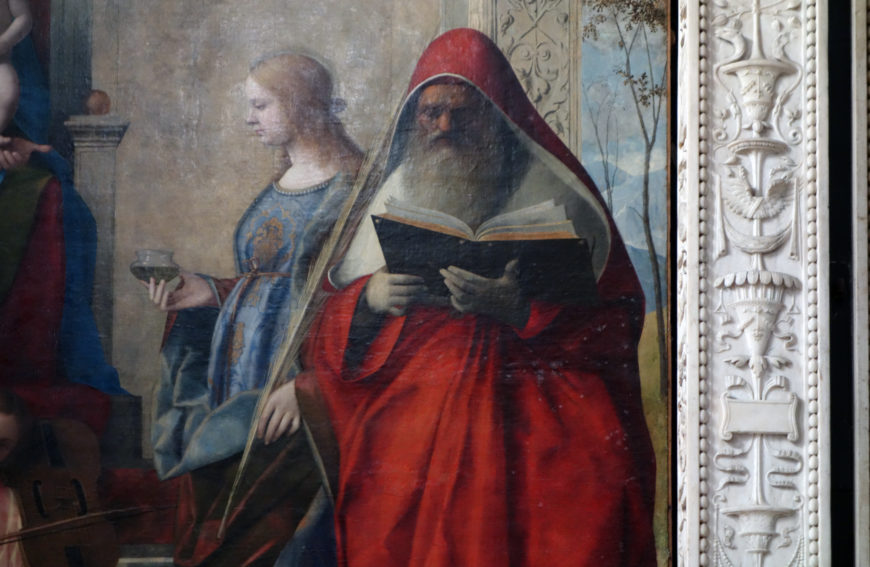
Saint Lucy and Jerome (detail), Giovanni Bellini, San Zaccaria Altarpiece, 1505, oil on wood transferred to canvas, 16 feet 5-1/2 inches x 7 feet 9 inches (San Zaccaria, Venice)
We also see St. Jerome dressed anachronistically as a cardinal of the church. St Jerome was considered one of the four Doctors of the Church, so he exemplified ecclesiastical authority. He was important for translating the Bible from Hebrew into Latin, making it more accessible to educated lay readers, and Bellini, who painted Jerome often, depicts him reading a book. Across from Jerome stands Peter, who was the rock of Christ’s church (Peter derives from “petrus” which means rock) and the first Pope, and holds the keys to the kingdom of Heaven. He stands for spiritual authority, and the controlling oversight of the church over religious communities.
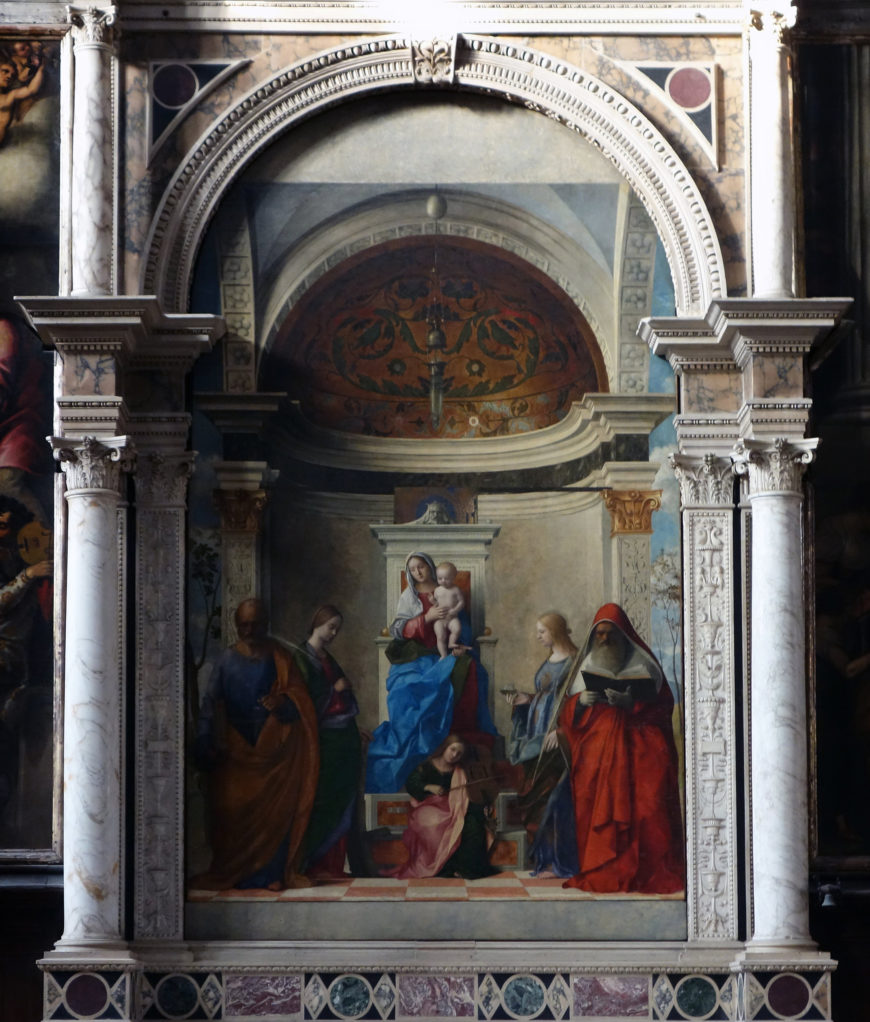
Giovanni Bellini, San Zaccaria Altarpiece, 1505, oil on wood transferred to canvas, 16 feet 5-1/2 inches x 7 feet 9 inches (San Zaccaria, Venice)
The Architecture and the light
The sacra conversazione takes place in a perfectly depicted little chapel that, because of the accuracy of the linear perspective (reinforced by the receding squares of the painted floor), the scale of the painting (which allows the figures to be the right size in terms of where they’re standing in relation to a viewer) and the integration of the real architecture of the frame with painted trompe l’oeil architecture in the painting, looks like it opens out from the architectural space of the church.
The painting is framed by a marble triumphal arch supported on pilasters decorated with running, floral scroll work. Inside the painting, we see two identical lateral arches, and another identical rear arch… There is virtually no break between the real architecture of the frame and the completely illusionistic, vaulted chapel in the painting — one exists on a continuum with the other. As Alberti prescribed in his book Della PIttura (On Painting), it feels as though we’re looking through a window. Any separation between the church and the world inside the painting disappears.
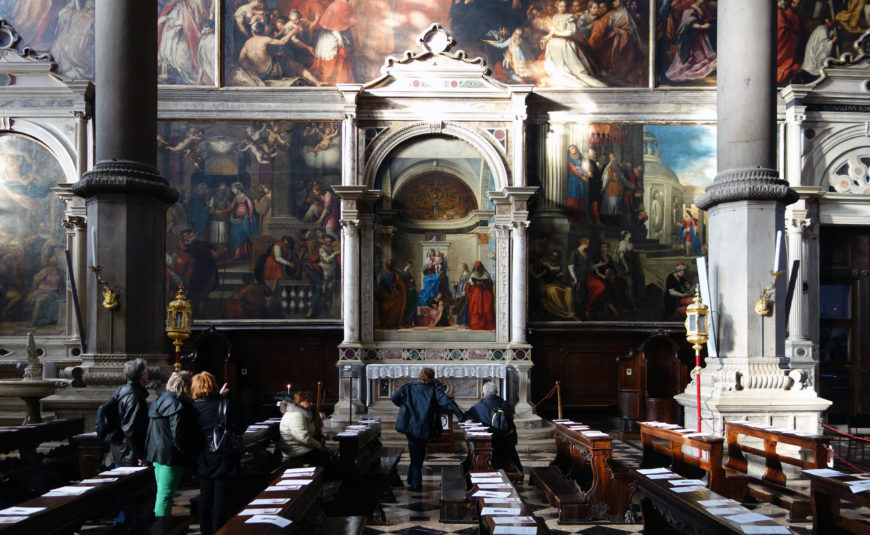
Giovanni Bellini, San Zaccaria Altarpiece, 1505, oil on wood transferred to canvas, 16 feet 5-1/2 inches x 7 feet 9 inches (San Zaccaria, Venice)
There’s another reason for this. As you enter the church, the painting is on the left wall of the church. Today, the interior of San Zaccaria is crowded with large-scale (mostly Baroque) paintings, hung in double registers along the walls. Bellini’s altarpiece stands out immediately because of its architectural frame, but also because it responds precisely to the natural light that enters the church from a window in the façade. Knowing the precise location of the altar, Bellini calculated the composition of the painting in accordance with this light. When the sun shines, and the light hits the painting, all the shadows cast by the painted figures and the architecture in Bellini’s fictional world fall in accordance to the real light in the church.This seamlessness of light and shadow increases the “reality” of the painting; we see the figures as solid, three-dimensional beings who are sharing our space.
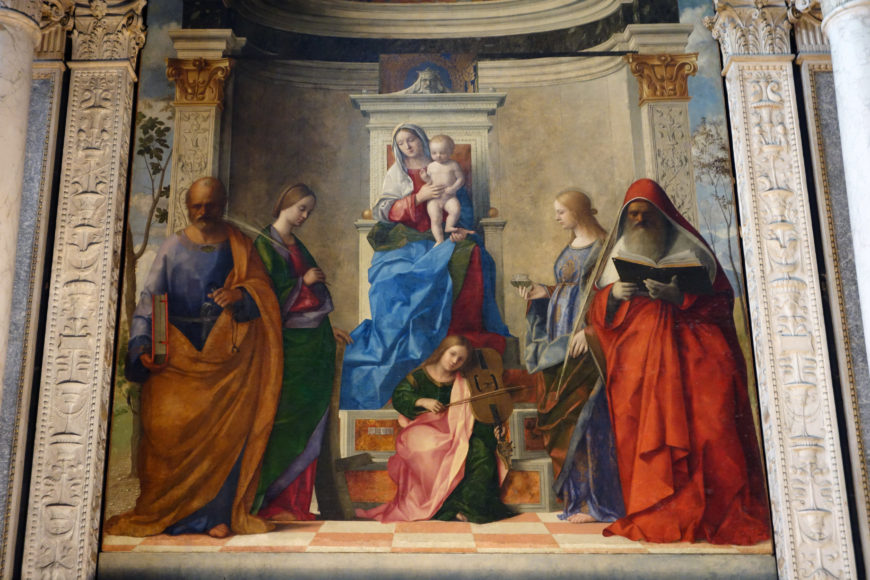
Giovanni Bellini, San Zaccaria Altarpiece, 1505, oil on wood transferred to canvas, 16 feet 5-1/2 inches x 7 feet 9 inches (San Zaccaria, Venice)
Disegno and colore
Of course, a modern viewer can increase the light by dropping a couple of euros into the coin box to turn on lamps that flood the painting with artificial illumination. And that’s fun, because it makes the colors pulsate with light and Bellini, as a painter, was fundamentally a colorist. There was a great debate in the Renaissance, and beyond, between the fundamental importance of disegno (drawing) and colore (color) in painting. The idea is that the Florentines thought disegno (composition, but also contour and clarity in drawing) was the most important thing, while the Venetians said that painting is nothing without colore; by which they meant not just the choice of colors, but the tonalities, contrasts, harmonies, and application of paint.
Look at how Bellini uses color in the figures. Peter wears blue and yellow, which are the characteristic colors of his robes; Jerome wears a glorious red. The two figures together are an essay in primary colors, but softened by Bellini’s application, which incorporates a lot of Leonardo’s gentle transitions in the areas of shadow. This is the glory of oil paint, which can be coaxed into the subtlest transitions in a single shade.
The female figures — the Virgin, St. Catherine and St. Lucy — wear primaries as well, but there’s also green which blends green and yellow and therefore adds a new harmony. The music-making angel alerts us to these harmonies, wearing green and the gentlest of pinks. If you look carefully, the same tones are found in the architecture, the mosaic, the landscape — Bellini writes music in paint.
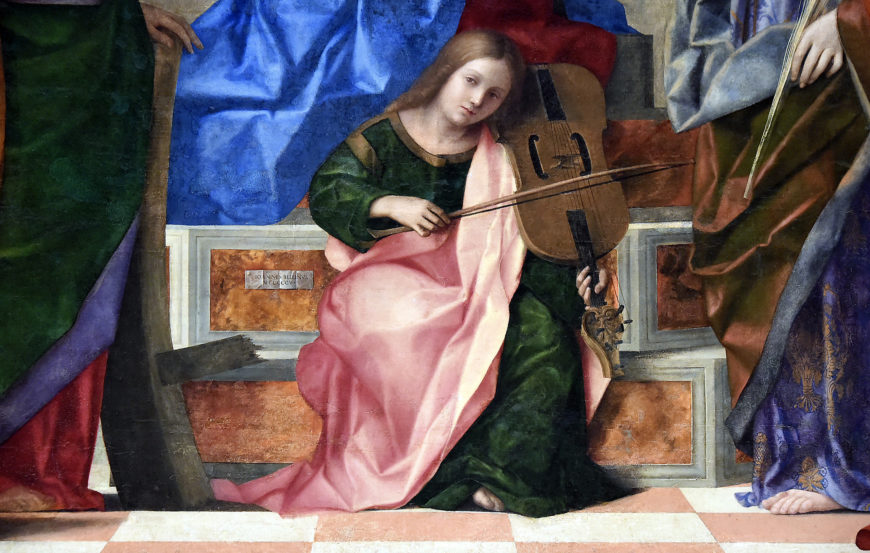
Angel (detail), Giovanni Bellini, San Zaccaria Altarpiece, 1505, oil on wood transferred to canvas, 16 feet 5-1/2 inches x 7 feet 9 inches (San Zaccaria, Venice)
The mosaic
Once you hear the music, you study the details. The rear arch frames the throne of the Virgin, sitting at the center of the space (not against the rear wall). The wall itself curves to form an apse-like space, crowned with a glittering half vault, painted to look like mosaic.
By the sixteenth century (even well before), mosaic work would have seemed anachronistic anywhere except Venice, which retained the Byzantine taste and expertise for mosaic. Frescoes are a near impossibility in Venice because the whole city sits in water that creeps up the masonry and seeps into the plaster, turning frescoes into sodden, salt-bloomed, indecipherable messes. Mosaics, set into proper mortar, are more durable. Plus, Venice was the European center for glassmaking, and produced quantities of gold glass that characterize Byzantine-style mosaic work.
The simulated glasswork in Bellini’s paintings is always astonishing, he was a master of the pictorial representation of gold-glass. The surface shimmers and shines, capturing and reflecting dancing shards of light. Below the mosaic, there is an elegant, curved entablature, echoed by a black marble band , which sets off the relief of the carving.
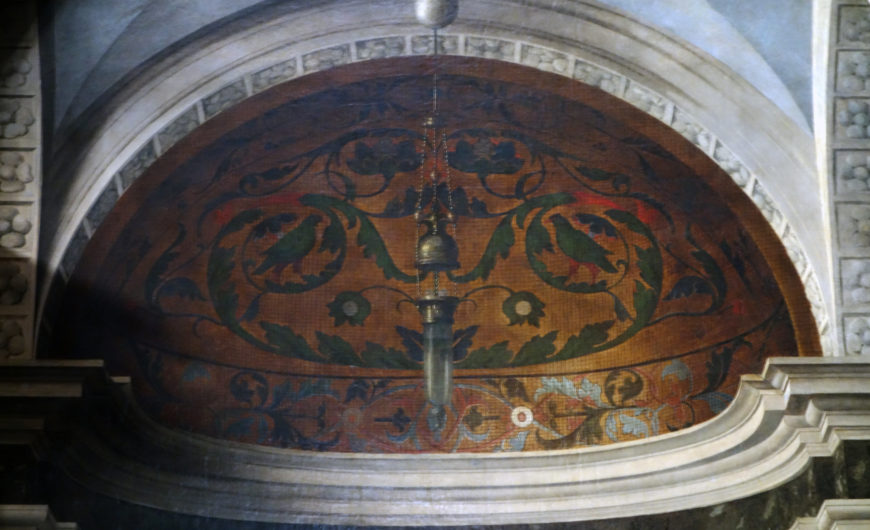
Apse dome (detail), Giovanni Bellini, San Zaccaria Altarpiece, 1505, oil on wood transferred to canvas, 16 feet 5-1/2 inches x 7 feet 9 inches (San Zaccaria, Venice)
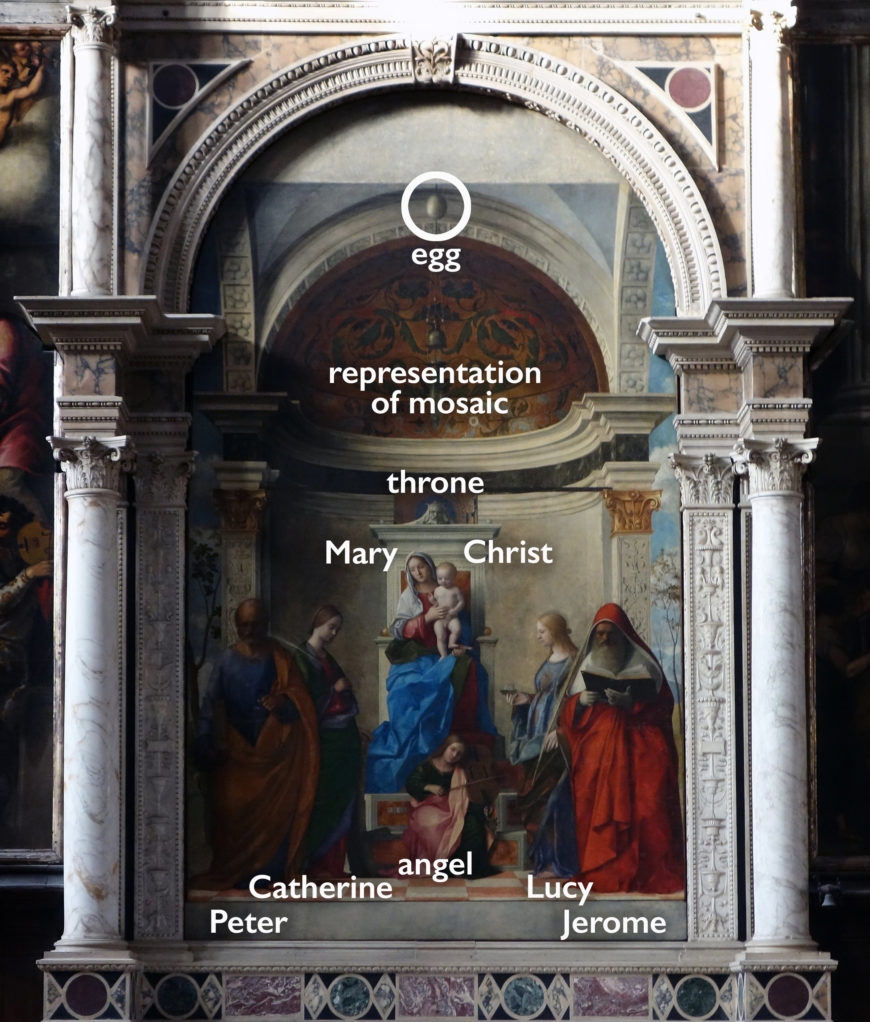
Diagram for Giovanni Bellini, San Zaccaria Altarpiece, 1505, oil on wood transferred to canvas, 16 feet 5-1/2 inches x 7 feet 9 inches (San Zaccaria, Venice)
The egg
A lantern, suspended from a large, perfect, oval ostrich egg, is located above the Virgin’s throne. We’ve seen this egg before, in the Montefeltro Altarpiece (c. 1474) of Piero della Francesca, made for the Duke of Urbino. The egg seems strange to modern eyes but is both symbolic and historically accurate. Ostrich eggs were often suspended in Coptic churches in Egypt (as well as in mosques) — apparently, something about the odor repelled spiders, which would be the practical aspect (in case you’re wondering, humans can’t detect the smell). More importantly, however, ostrich eggs also have Christological significance because they are hatched by the heat of the sun. The analogy is to the miraculous conception and birth of Christ. Pearls carry the same symbolism because they are spontaneously born from oyster shells. Miracles in nature are used an analogies for the miracle of Christ.
The throne
Finally, the Virgin’s throne is a simple, stepped, rectangular structure of white and yellow marbles, punctuated by globed, gold finials on the arms, and topped by the carved head of a king. This is Solomon, renowned for his wisdom and mercy, reinforcing the importance of learning both in theory and in practice. Behind him there is an elegant, woven Persian-motif carpet, suspended from an iron crosstie, a reference to the Virgin’s cloth of honor. Miraculously, the little illusionistic chapel is not completely enclosed. The lateral arches are open to provide an outdoor view. The two slivers of landscape include a glimpse of blue sky and slim, elegant trees springing up from a green lawn. The landscape admits painted “natural” light into the chapel, which helps to illuminate the figures. It also transports us out of Venice and into the world of the painting, making the illusion complete.
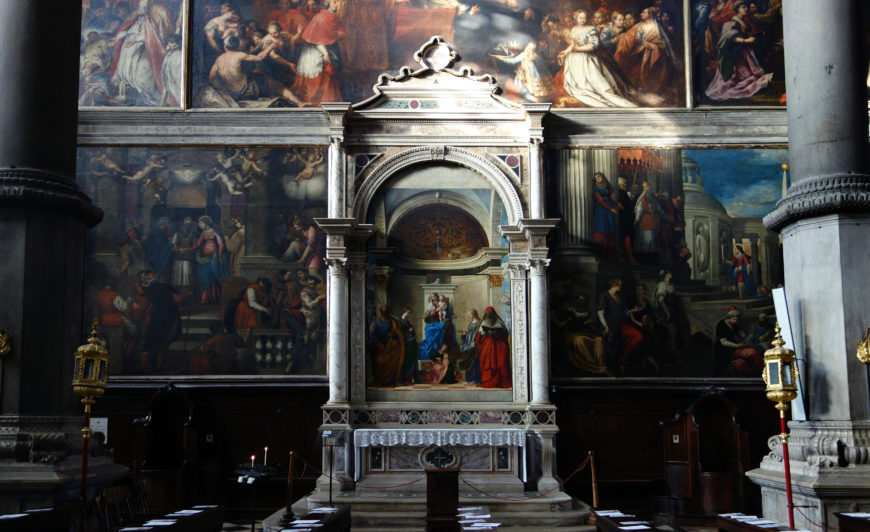
Giovanni Bellini, San Zaccaria Altarpiece, 1505, oil on wood transferred to canvas, 16 feet 5-1/2 inches x 7 feet 9 inches (San Zaccaria, Venice)
About Bellini
Bellini was 74 years old when he completed the San Zaccaria Altarpiece. Having grown up in his father’s workshop, he was a painter from the moment he was born. Almost all his work was made for Venice, and most of his paintings are devotional works depicting the Madonna and Child in various iconographical permutations rooted in Byzantine tradition. In its monumentality, classically inspired architecture, and treatment of color and light, this altarpiece is his most perfect synthesis of that tradition with the new values of Renaissance art.
Note: Centuries later, the San Zaccaria Altarpiece was considered such a masterpiece that in 1787, when Napoleon ransacked the city, he had his troops steal it, cutting it from its frame. This explains the missing area at the top of the painting, just below the frame of the crowning arch. During its time in France, the painting was subjected to a radical new form of conservation intervention; the supporting panel was stripped down so that the paint surface could be removed and then it was glued to a canvas support (it has since been transferred back to panel — long story). At the time, it was thought that paintings should be on canvas, and presumably the change of support also made the works lighter and easier to hang and frame in Napoleon’s new museum. The return of the painting to its rightful place in Venice brought it back to life, allowing it to be experienced as Bellini intended.
Additional resources:
A short biography of the artist from The National Gallery, London
Renaissance Paragone: Disegno and Colore (Oxford Art Online)
Disegno e colore (Italian Renaissance Learning Resources)
Smarthistory images for teaching and learning:
[flickr_tags user_id=”82032880@N00″ tags=”zaccaria,”]

